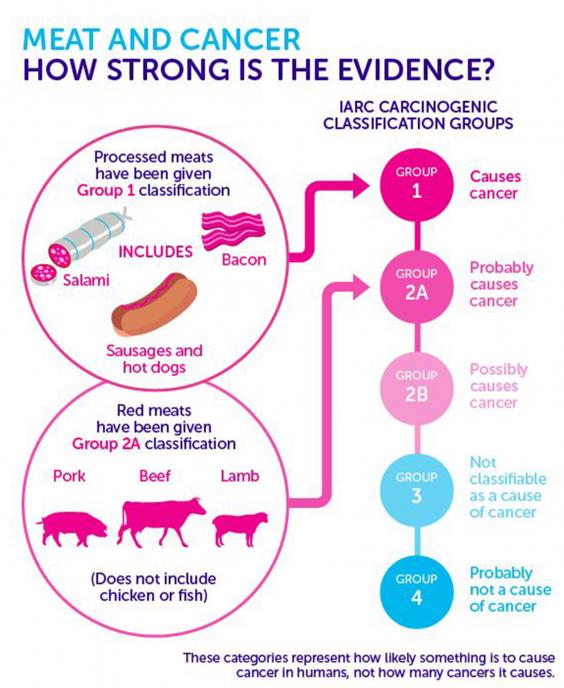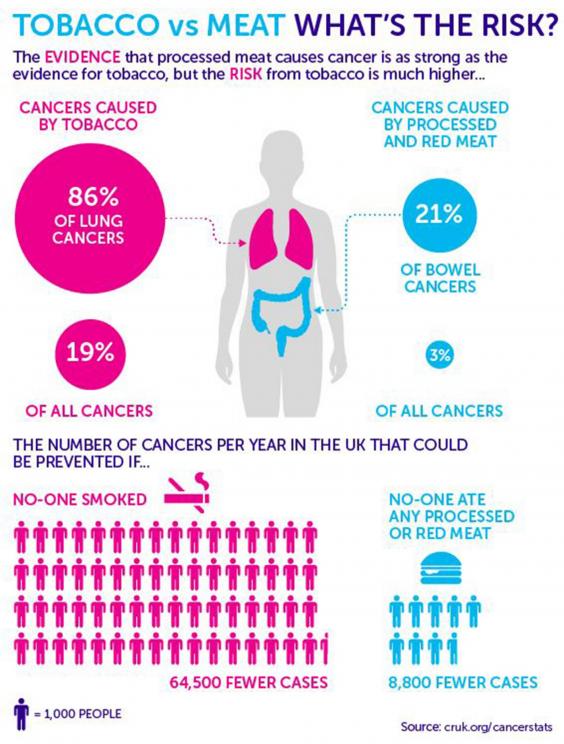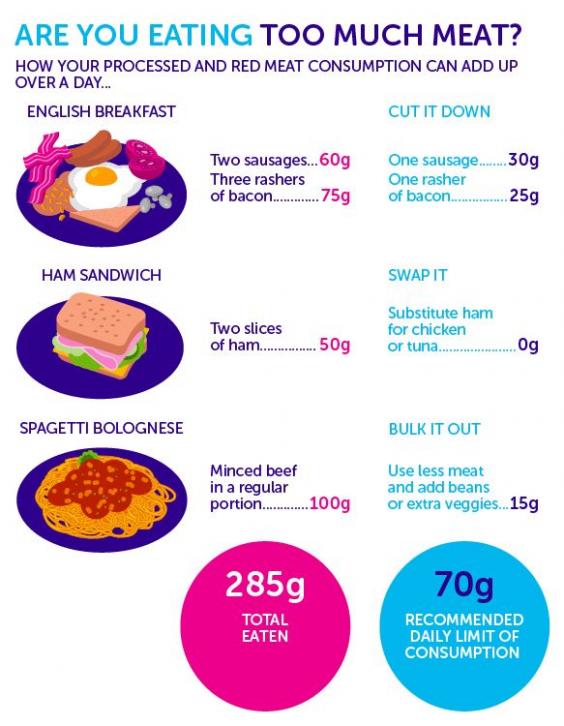
Deadly
Cancer 'definitely' caused by processed meat - what you need to know
Theory had been widely understood for a number of years but the announcement from the IARC confirms suspicions
You’ve probably seen today’s headlines, about the fact that processed meat has been classified as a ‘definite’ cause of cancer.
And red meat is a ‘probable’ cause.

S/he who lives by the carving knife dies by the carving knife.
The decision – coordinated by a respected international body – has been so highly anticipated by the media that speculation about the announcement has been building since last week.
But a link between certain types of meat and some forms of cancer – notably bowel cancer – isn’t ‘new’ news – the evidence has been building for decades, and is supported by a lot of careful research.
Nevertheless, today’s announcement is significant. It comes from the International Agency for Research on Cancer (IARC) – a group of international experts who scrutinise the overall evidence – in this case more than 800 studies – on how likely certain things are to cause cancer. Their decisions carry a lot of clout, especially with governments and regulators.
But what does the finding – published here in the Lancet Oncology – mean in practice? How much meat is it sensible to eat? And how many cases of cancer are linked to meat consumption?
In this post, we’ll look at what IARC’s classification actually means, how red and processed meat affect cancer risk, and the likely size of this effect.
But before we move on, let’s be clear: yes, a prolonged high-meat diet isn’t terribly good for you. But a steak, bacon sandwich or sausage bap a few times a week probably isn’t much to worry about. And overall the risks are much lower than for other things linked to cancer – such as smoking.


What are ‘red’ and ‘processed’ meat?
First, let’s clear up some definitions.
‘Red’ meat is (as you might expect), any meat that’s a dark red colour before it’s cooked – this obviously means meats like beef and lamb, but also includes pork.
‘Processed’ meat is meat that’s not sold fresh, but instead has been cured, salted, smoked, or otherwise preserved in some way (so things like bacon, sausages, hot dogs, ham, salami, and pepperoni). But this doesn’t include fresh burgers or mince.
Both of these types of meat are distinct from ‘white’ meats, like fresh chicken or turkey, and fish (neither of which appear to increase your risk of cancer).
The evidence so far…
There’s now a large body of evidence that bowel cancer is more common among people who eat the most red and processed meat. As this evidence has steadily built up, Cancer Research UKhave blogged about it several times – and it’s covered on the NHS Choices website and by the World Cancer Research Fund(WCRF).
(There’s also growing evidence for a possible link to both stomach and pancreatic cancers, but this seems to be less clear cut than the link to bowel cancer.)
The most convincing overview of the evidence of a link to bowel cancer comes from a2011 analysis by researchers at the WCRF, who combined the results of a number of previous studies, to try to get a clear sense of the overall picture.
They were able to group the data according to those who ate the most red and processed meat and those who ate the least. A key finding from the WCRF analysis is that red meat and processed meat aren’t equally harmful: processed meat is more strongly linked to bowel cancer than red meat.
The results showed that those who ate the most processed meat had around a 17 per cent higher risk of developing bowel cancer, compared to those who ate the least.
‘17 per cent’ sounds like a fairly big number – but this is a ‘relative’ risk, so let’s put it into perspective, and convert it to absolute numbers. Remember these are all ball-park figures – everyone’s risk will be different as there are many different factors at play.
We know that, out of every 1000 people in the UK, about 61 will develop bowel cancer at some point in their lives. Those who eat the lowest amount of processed meat are likely to have a lower lifetime risk than the rest of the population (about 56 cases per 1000 low meat-eaters).
If this is correct, the WCRF’s analysis suggests that, among 1000 people who eat the most processed meat, you’d expect 66 to develop bowel cancer at some point in their lives – 10 more than the group who eat the least processed meat.
How does red and processed meat cause cancer?
Researchers are still trying to pin down exactly how red and processed meat cause cells to become cancerous, but the main culprits seem to be certain chemicals found in the meat itself.
In red meat, the problems seem to start when a chemical calledhaem – part of the red pigment in the blood, haemoglobin – is broken down in our gut to from a family of chemicals called N-nitroso compounds. These have been found to damage the cells that line the bowel, so other cells in the bowel lining have to replicate more in order to heal. And it’s this ‘extra’ replication that can increase the chance of errors developing in the cells’ DNA – the first step on the road to cancer.
On top of this, processed red meats contain chemicals that generate N-nitroso compounds in the gut, such as nitrite preservatives.
Cooking meat at high temperatures, such as grilling or barbequing, can also creates chemicals in the meat that may increase the risk of cancer. These chemicals are generally produced in higher levels in red and processed meat compared to other meats.
But there are other theories too – some research has suggestedthat the iron in red meat could play a role, while others suggest thebacteria in the gut might play a supporting role too.
So despite what you may hear, it isn’t about the quality of the meat, or whether it’s from the local butcher or your supermarket. The evidence so far suggests that it’s probably the processing of the meat, or chemicals naturally present within it, that increases cancer risk.
What does this decision from IARC mean?
Whatever the underlying mechanism, there’s now sufficient evidence for IARC to rule that processed meat ‘definitely’ causes cancer, and that red meat ‘probably’ causes cancer. But to really understand what this means (and doesn’t mean), you need to know a bit about IARC’s categories.
When IARC assesses the evidence on a particular cancer risk, it assigns it to one of several groups, which – as the graphic below shows – represent how confident they are that it causes cancer in people.


Processed meat has been classified as a ‘definite’ cause of cancer (or Group 1 carcinogen) – the same group that includes smoking and alcohol. And red meat is a ‘probable’ cause of cancer (or a Group 2a carcinogen) – the same group as shift work. While this may sound alarming, it’s important to remember that these groups show how confident IARC is that red and processed meat cause cancer, not how much cancer they cause.
When Cancer Research UK covered a previous IARC decision on diesel emissions, Professor David Phillips, an expert in the causes of cancer, summed it up beautifully:
"IARC does ‘hazard identification’, not ‘risk assessment’. That sounds quite technical, but what it means is that IARC isn’t in the business of telling us how potent something is in causing cancer – only whether it does so or not. To take an analogy, think of banana skins. They definitely can cause accidents – but in practice this doesn’t happen very often (unless you work in a banana factory). And the sort of harm you can come to from slipping on a banana skin isn’t generally as severe as, say, being in a car accident. But under a hazard identification system like IARC’s, ‘banana skins’ and ‘cars’ would come under the same category – they both definitely do cause accidents.
To put things in perspective, let’s look at how red and processed meat stack up against smoking:
In 2011, scientists estimated that around 3 in every hundred cancers in the UK were due to eating too much red and processed meat (that’s around 8,800 cases every year). This compares against 64,500 cases every year caused by smoking (or 19 per cent of all cancers).
So what does this mean for mealtimes?
Does red and processed meat still have a place in a healthy diet?
None of this means that a single meat-based meal is ‘bad for you’. What it does mean is that regularly eating large amounts of red and processed meat, over a long period of time, is probably not the best approach if you’re aiming to live a long and healthy life. Meat is fine in moderation – it’s a good source of some nutrients such as protein, iron and zinc. It’s just about being sensible, and not eating too much, too often.
So how much is a ‘sensible’ amount of meat? This is a much trickier question to answer. The evidence so far doesn’t point to a particular amount that’s, in terms of cancer risk, likely to be ‘too much’. All we can say is that on the whole, the risk is lower the less you eat. Based on a range of health considerations, the Government advises people who eat more than 90g (cooked weight) of red and/or processed meat a day should cut down to 70g or less.
But what do these portions actually look like?
So if you’re someone who has a very meaty diet, and you’re worried about cancer, you may want to think about cutting down. That doesn’t mean you need to start stocking up on tofu, unless you want to, it just means trying to eat smaller and fewer portions (by adding in more vegetables, beans and pulses – remember the eatwell plate?), or choosing chicken or fish instead. As we said above, there’s no strong evidence linking fresh white meats such as chicken, turkey, or fish to any types of cancer.
So our advice on diet stays the same: eat plenty of fibre, fruit and vegetables; cut back on red and processed meat, and salt; and limit your alcohol intake. It might sound boring but it’s true: healthy living is all about moderation.
Except for smoking: that’s always bad for you.
Casey Dunlop is a health information officer at Cancer Research UK
Read the original article here


No comments:
Post a Comment